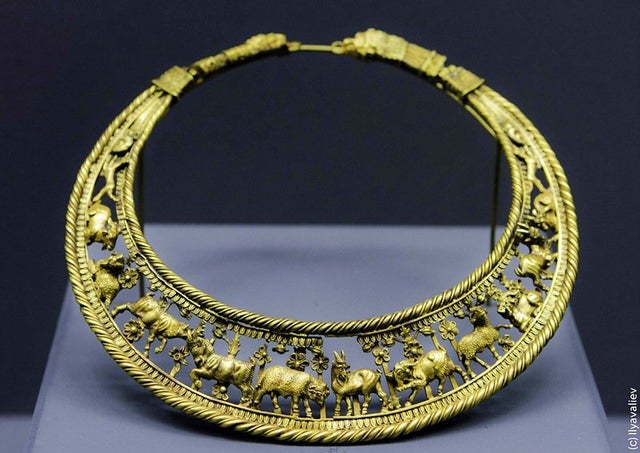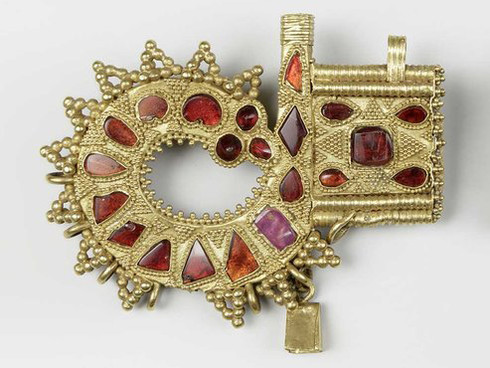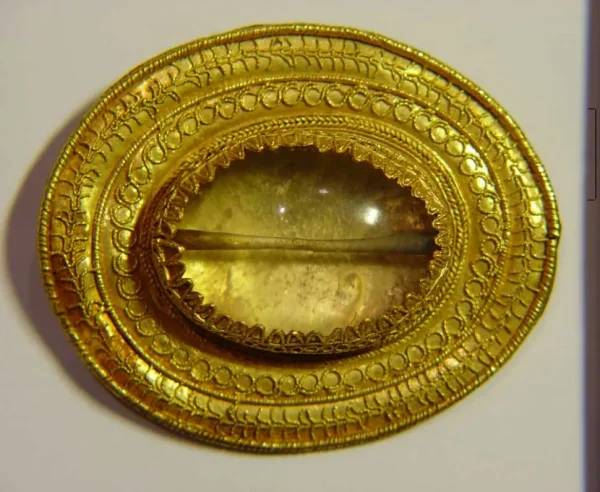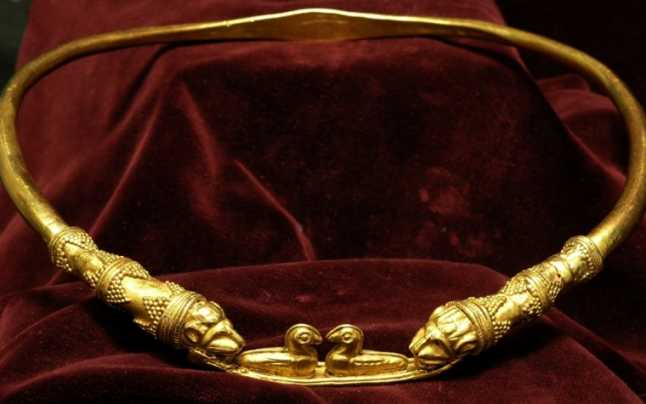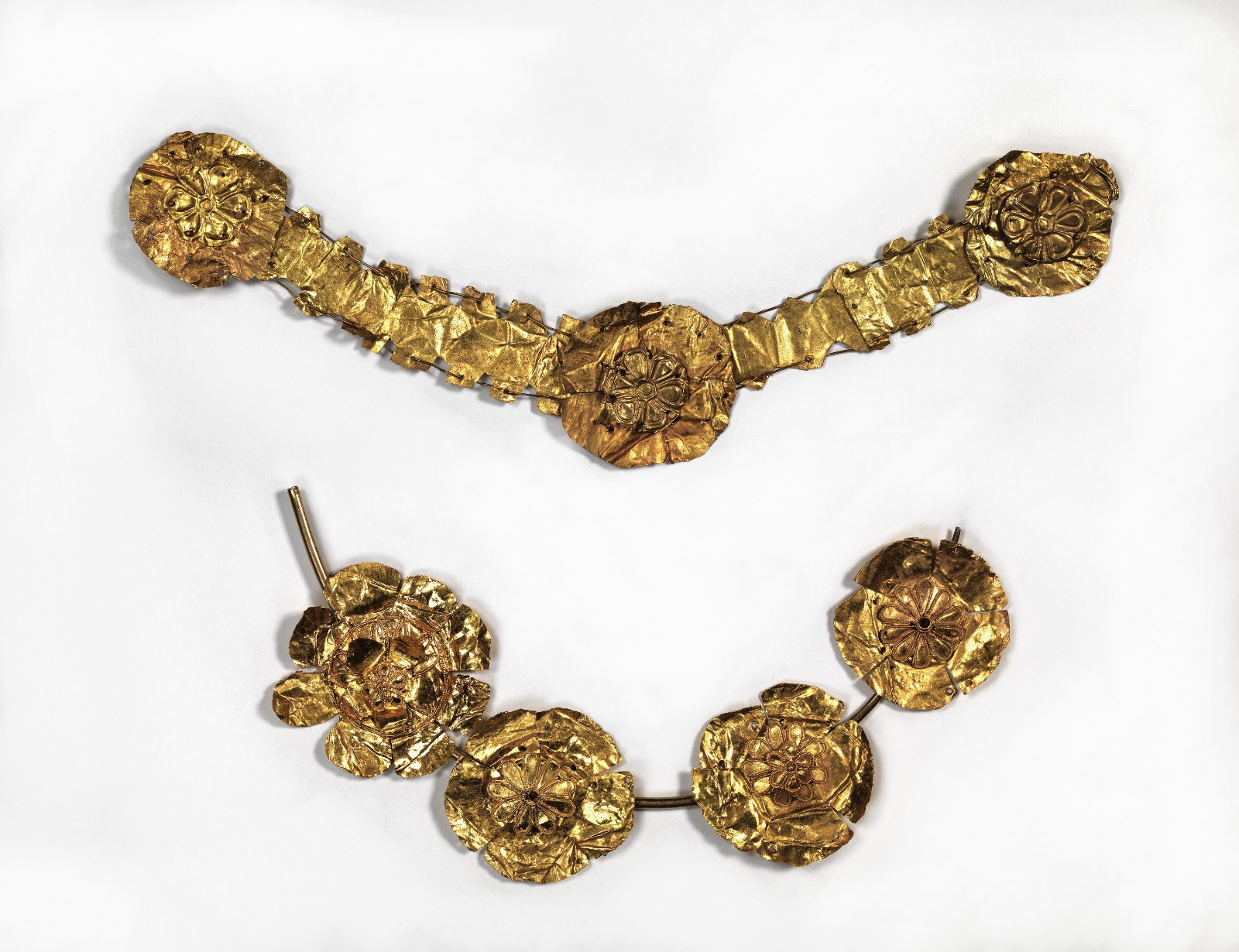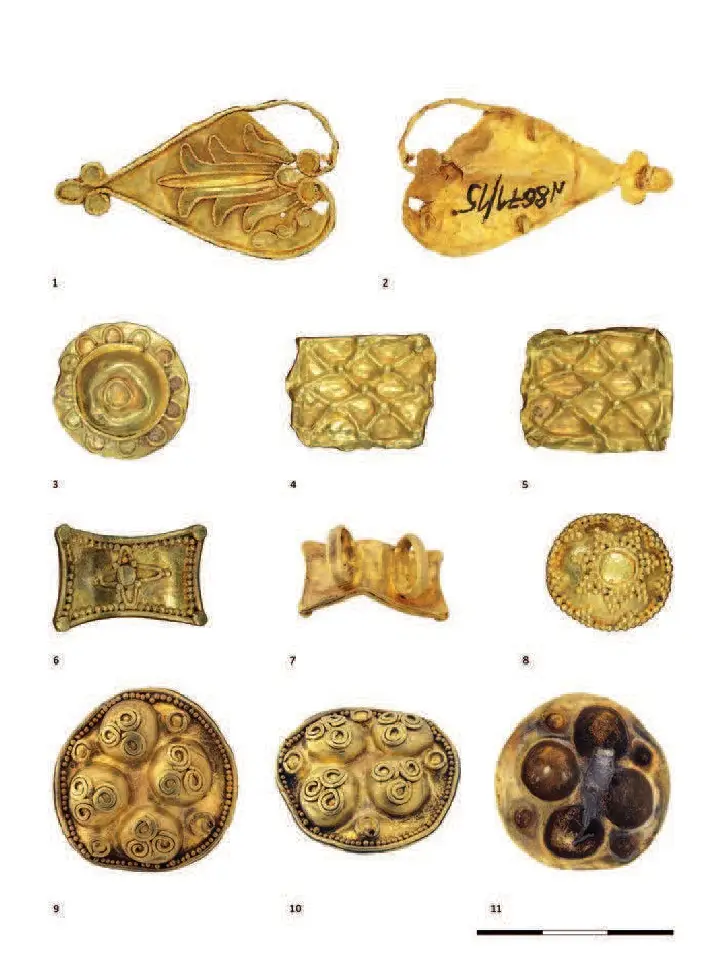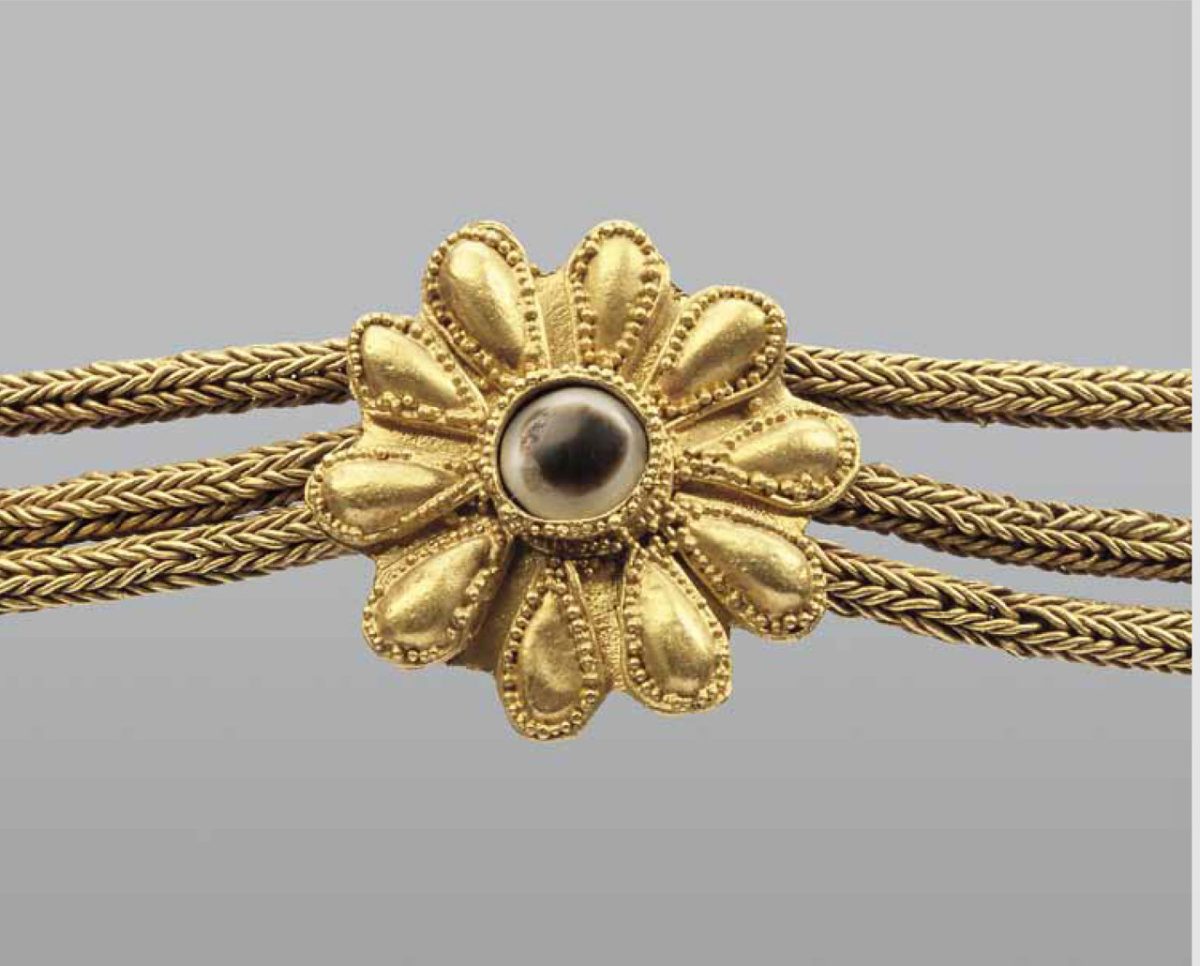


Diadem 8th-7th century BCE; gold with sardonyx, length 63 cm.
Scythian Archaic period, found in the Litoi Kurgan, Kuban region.
It is assumed to be of Urartian or Syrian origin and subsequent re-work by the Scythians
Северное Причерноморье, Приднепровье, Мельгуновский (Литой) курган. Раскопки А. П. Мельгунова в 1763 г. Инв. № Дн.1763-1/18 (Hermitage)
Alekseev A. Yu. The Gold of the Scythian Kings. St. Petersburg, 2012 >> https://www.academia.edu

The Hermitage article on the Kelermes burial mounds
http://edu.hermitage.ru/catalogs/1418203874/themes/1418244952/article/1418245462
Kelermes kurgans are a classic monument of the Scythian archaism. They were built mainly in the second half of the 7th century BCE. The Scythian burial ground appeared on the site of the Bronze Age burials of the 3rd – 2nd millennium BCE and consisted of a chain of 34 kurgans – the graves of the nobility; and a burial-free necropolis of the ordinary population. Many burial mounds, although plundered in antiquity and suffered greatly from unscrupulous and plundering excavations at the beginning of the 20th century, contained a wealth of material – the memory of the Scythian campaigns in the Near East.
Academician G.F. Miller and the Treasures from Litoi Kurgan
Irina V. Tunkina >> http://ranar.spb.ru/files/visual/Tunkina_PDF/Tunkina_Litoy%20kurgan.pdf

“A gold diadem used to decorate a headdress (listed in the inventory as “one small gold chain”) and dated to the 8th or 7th century BC of Urartian or Syrian origin (Fig. 3, 5, 15-16). It consists of three plaited ropes worked in
gold wire inserted through nine rosettes fashioned from gold leaf (six rosettes with 9 petals, a central one with 10 decorated with sardonyx and two starshaped ones) and decorated with granulation The ropes have clasps at each
end, which are decorated with a geometric pattern made of granulation and to these are fastened small chains with crescent pendants and nine hollow balls made from granulation. Miller regarded it as a neck-chain and was
enraptured by the quality of the workmanship: it consisted “of three rows of skillfully interwoven angular links which were wrought in such a fine and pure fashion, as if the article was of our time”. “At each end of the chain – as is duly
shown in the drawing” wrote Miller,” six balls were suspended, but when I received these articles, there were only three suspended at each side and three were separate, which I then ordered to be fastened on and the extra three were added in the drawing by the painter so that they should match”. These attempts at reconstruction were later rejected by E.M. Pridik, who was of the opinion that originally there had been 16 of the small metal balls.”

p.124 https://repository.upenn.edu
OTHER FINDS from the Kelermes burial mounds
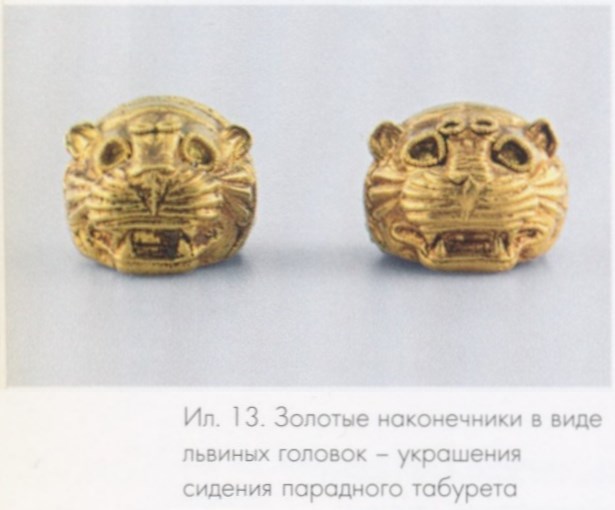
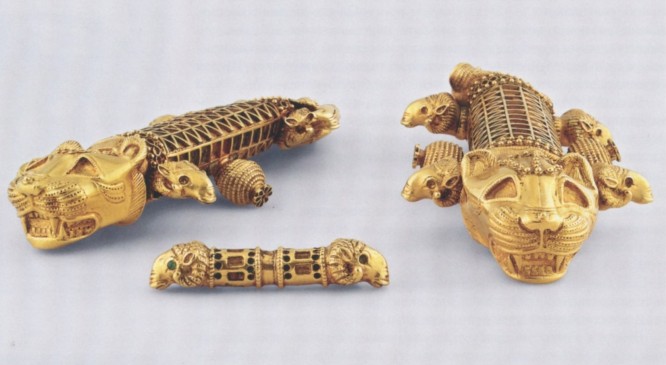

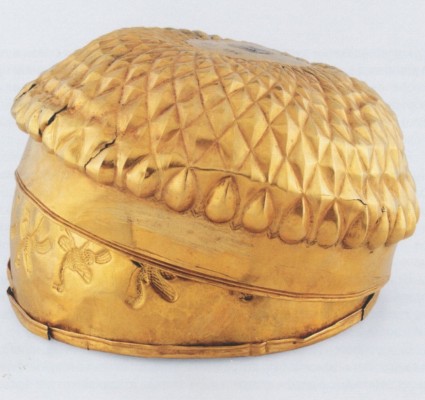
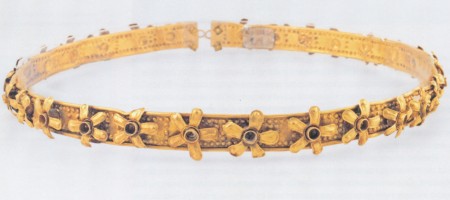
Л.К. Галанина
Скифские древности Северного Кавказа в собрании Эрмитажа. Келермесские курганы.
// СПб: Изд-во Гос. Эрмитажа. 2006. 80 с. (Коллекции Эрмитажа)
ISBN 5-93572-185-6 >> http://kronk.spb.ru/library/galanina-lk-2006-04.htm
А.Ю. Алексеев
Золото скифских царей в собрании Эрмитажа.
// СПб: Изд-во Гос. Эрмитажа. 2012. 272 с. ISBN 978-5-93572-459-7 >> http://kronk.spb.ru/library/alekseev-ayu-2012-1.htm
“Gold Treasury” of the Hermitage Museum, website with great pictures >> https://vk.com/@hm_visiting-zolotaya-kladovaya
М.И. Артамонов
Сокровища скифских курганов в собрании Государственного Эрмитажа.
// Прага — Л.: «Артия», «Советский художник». 1966 >> http://kronk.spb.ru/library/artamonov-mi-1966.htm
part with illustrations >> http://kronk.spb.ru/library/artamonov-mi-1966-add1.htm

Quiver clasp, fastener
Created: Middle of the 7th century BCE
Found: Kelermes Barrow No. 3. Trans-kuban
https://www.hermitagemuseum.org

5 — наконечник с розеткой, Келермес, к. 3 Ш (ГЭ. Инв. NoКу 1904-1/2); 6 — браслет с розеткой с рельефа Саргона (по Maxwell-Hyslop 1971: fi g. 148: b); 7 — браслет и наручное украшение с рельефа Ашурнасирпала II (по Maxwell-Hyslop 1971: fi g. 143)
5 — pole-top ending in a rosette, Kelermes, mound 3 Sh (SH. Inv. no. Ку 1904-1/2); 6 — bracelet with applique rosette from relief of Sargon (after Maxwell-Hyslop 1971: fig. 148: b); 7 — bracelet and armlet from relief of Ashurnaşirpal II (after Maxwell-Hyslop 1971: fig. 143)
Source:
Формирование раннескифского культурного комплекса Келермесского могильника в Закубанье
Tatyana V. Ryabkova (Author)
The Formation of the Early Scythian Cultural Complex of the Kelermes Burial Ground in Trans-Kuban
Author: Tatyana V. Ryabkova
https://www.ceeol.com/search/article-detail?id=778609
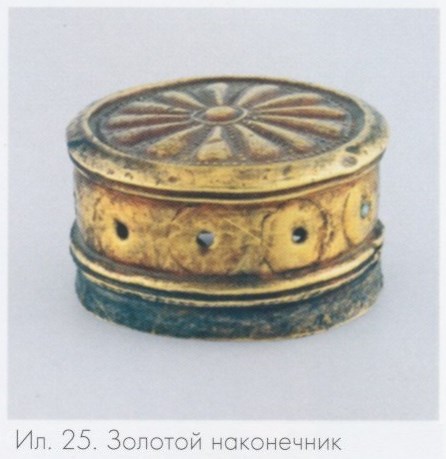
Золотой наконечник
В центре могилы помещалась жертвенная известняковая плита со сквозным отверстием посередине для возлияния подземным богам. Её Шульц отдал одному из крестьян в качестве платы за участие в раскопках. В юго-западной части могилы лежал скелет, обращённый черепом на север. Вероятнее всего, это были останки знатной женщины, голову которой увенчивала золотая диадема с головкой грифона в центре (ил. 14). Ей же принадлежала золотая витая шейная гривна, проданная Шульцем в Ростове. У левой руки найдены золотые цепочки (ил. 24) и золотой наконечник с розеткой (ил. 25).
Л.К. Галанина
Скифские древности Северного Кавказа в собрании Эрмитажа.
Келермесские курганы.

